U.S. Courthouse & Federal Building Facade Project
November 19, 2019
In 2018-2019 the General Services Administration contracted with the Tradesmen Group and other subcontractors to perform an extensive renovation of the building’s exterior. This is a recording of the “wrap-up” session explaining their work.
Federal Judges Association Newsletter
February 28, 2006
Beautiful Courthouse
Editor’s Note: Former FJA Secretary J.P. Stadtmueller (E.D.Wis.) thoroughly explores the history and architectural grandeur of the Milwaukee courthouse where he has served for 35 years, first in the U.S. Attorney's Office and then as a Judge. Of particular note are the exterior granite walls, the soaring central atrium and the magnificent ceremonial courtroom, all pictured below. Looking at the walls, we can understand why J.P.'s children used to say that their Dad "went to work at a castle every day."
Milwaukee's "Crown Jewel"
The Historic United States Courthouse and Federal Building
by Judge J. P. Stadtmueller, E.D. Wis.
One of the most striking examples of Landmark buildings in the United States is to be found in the historic United States Courthouse and Federal Building located in Milwaukee, Wisconsin. Originally authorized for principal use as a United States Post Office, Court and Customs House, land located just three blocks from Lake Michigan in downtown Milwaukee was acquired by Congress through a series of acts approved beginning in 1889. The 2.1 acre parcel, consisting of an entire block bounded by Wisconsin Avenue on the north, Michigan Street on the south, Jackson Street on the east and Jefferson Street on the west, was secured through condemnation with an award of $388,354 on October 31, 1890.
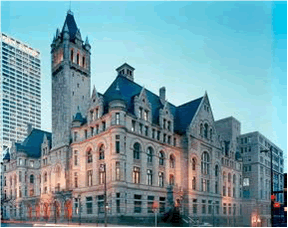
Courthouse at Dusk
Construction of the picturesque five-story, 302,000 square foot edifice began in 1892 and was completed seven years later at a total cost of $1,432,210.81. The architect for the building is listed as Willoughby J. Edbrooke, Supervising Architect of the Treasury Department, whose design was inspired by H. H. Richardson's Allegheny County Courthouse in Pittsburgh, Pennsylvania (circa 1883). Edbrooke also designed nearly identical post office buildings constructed in Washington, D.C. (also completed in 1899); St. Paul, Minnesota; and Omaha, Nebraska.
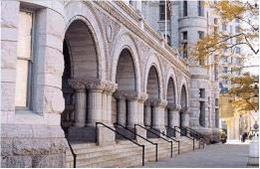
Front Entrance
The building exterior is a pale gray Mount Waldo granite from Frankfurt, Maine. The rich exterior facades are carved with Romanesque leaf ornamentation that includes intricate faces and gargoyles. The exterior walls are constructed with blocks of granite that are alternatively rough and smooth-dressed and rise to a steeply pitched hipped slate roof punctuated with a variety of gabled projections along the fifth floor roof line. A soaring tower framed by pinnacles rises from the center of the facade, terminating in an arched belfry and a high pyramidal roof. It is noteworthy that the original drawings called for a four-sided clock to be incorporated in a 190 foot tower; however, this segment was eliminated during construction, apparently owing to economic considerations.
The building facade is broken into recesses and projections, creating a dynamic composition punctuated by an arcaded entrance on the first level and Roman arches over the second and third story fenestration. The massive stone forms are relieved with fine decoration including Romanesque carved moldings and detailed stonework which surrounds the arcaded main entrance and second floor portico. The corners of the original structure are rounded with tall pinnacles that again include alternating bands of smooth and rough-faced granite and are capped with conical roofs of copper and slate. Like the facade, the east and west elevations are ornamented and symmetrically balanced, prominently featuring a projecting gable with a variety of arched fenestration.
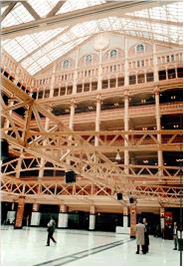
Atrium - View 1
Interior space on each of the five floors is arranged around an expansive central atrium surrounded by wide corridors and capped with massive arched-steel roof trusses covered with a glass skylight. The building's corridors, stairways and lobbies are adorned with inlaid multicolored marble mosaics, raised-panel oak doors and jambs, and decorative plastered ceilings.
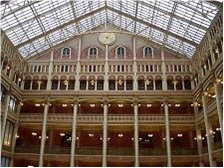
Atrium - View 2
When the building opened, the entire first floor was occupied by its largest tenant, the U.S. Post Office. The third floor was occupied principally by the U.S. Courts, and later included offices for the United States Attorney and U.S. Marshal. The second, fourth and fifth floor tenants included the Bureau of Animal Industry, Civil Service, Customs, Internal Revenue, Lighthouse Inspector, Locomotive Inspector, Oleomargarine Department, Pension Examiner, Postal Inspectors, Railway Mail Service, Steamboat Inspectors, U.S. Engineer, Weather Bureau and the Wine and Spirit Department.
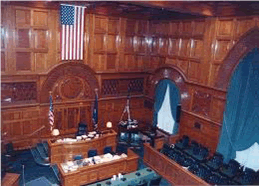
Ceremonial Courtroom
The court's third floor court space included two chambers and courtrooms. The smaller of the two facilities was assigned to the district court and included a modest-sized, marble lined courtroom that included a mahogany bench, trim and frescos. The second, much larger, facility included a magnificent 2,200 square foot courtroom fitted with raised-panel doors and jambs, and floor-to-ceiling raisedpanel walls which rise 27 feet to a coffered wood panel ceiling, all constructed in select quartersawn white oak. Intricately carved decorative accents and trim are to be found throughout, including a Federal emblem and State of Wisconsin and City of Milwaukee seals positioned behind the judge's bench, which itself is a work of art. In addition, a large marble-faced clock with black Roman numerals is positioned high on the wall at the rear of the courtroom. The courtroom and adjacent chambers remain essentially intact, making it one of the most magnificent courtrooms in the United States.1
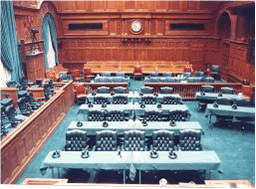
View from Bench - Ceremonial Courtroom
The building remained under the control and management of the U.S. Postal Office Department until 1939, when it was taken over by the Public Building Administration (PBA). The following year PBA became a branch of the Federal Works Agency which, in 1949, was absorbed by the General Services Administration (GSA). The building is currently maintained by the Public Buildings Service (PBS), a service of GSA.
Two additions, the first of which was completed in 1932, added five stories, a basement and sub-basement on the south side of the original structure, and a second, completed in 1941, added two additional floors. Like the 1899 structure, the exterior is clad in granite and includes some arched fenestration to replicate the original design. However, owing to both architectural and economic considerations, the addition lacks both the gable and steeply hipped slate roof as well as much of the ornamentation found in the original design. The interior corridors and lobbies are marked with much less ornamentation, which includes steel doors and frames rather than traditional raised-panel wood doors and frames, terrazzo floors rather than marble, and more limited ornamentation in the plastered ceilings.
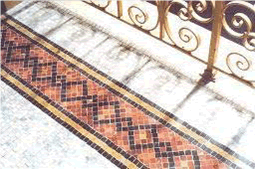
Detail of Inlaid Mosaic Floor
In 1983, following the results obtained in the restoration of the Old Post Office at 12th and Pennsylvania Avenue, Washington, D.C., Wisconsin Senator Robert W. Kasten, Jr. and Terry Golden, then Administrator of GSA, secured $18.4 million in initial prospectus funding from Congress to restore the Courthouse and Federal Building in Milwaukee. In the 20 years that followed, more than $35 million was expended in extensive restoration work that included (1) restoring all of the building's original interior finishes; (2) replacement of much of the building's infrastructure, including a new 100-year slate roof, energy efficient glass panels in the skylight, and new elevators and heating and ventilation equipment; and (3) a host of security initiatives.
Beginning with the U.S. Post Office relocating its main operations to a new postal facility in 1968, and continuing over the next 20 years, virtually every law enforcement agency housed in the building was relocated to other federal or leased facilities, primarily to accommodate additional space needs for the courts.
Indeed, today the building's principal tenant is the United States Courts, including chambers for three circuit judges, a circuit library, chambers and courtrooms for six district judges, three full-time magistrate judges, four bankruptcy judges, and the tax court, clerks' offices for the district and bankruptcy courts, jury assembly room, probation office, and federal defender's office, which, taken together, account for approximately 70% of the available building space.
To be sure, the United States Courthouse and Federal Building in Milwaukee, Wisconsin, has endured the test of time as an architectural "Crown Jewel" and will continue to be treasured as a functional part of our nation's history.
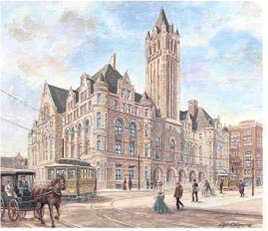
Federal Courthouse in 1899 (reprint courtesy of Lynn Casper)
1 So as not to confuse the circuit court of the 1800s with the current regional circuit court structure, a bit of history is in order. As the country grew and the population began to move westward throughout the 1800s, so also did the Federal court system, and by 1899 it entered its final stages of development. During this phase, district courts held jurisdiction to adjudicate petty federal crimes, forfeitures, penalties and admiralty cases. At the same time, the circuit court entertained all major federal civil and criminal cases as well as those related to citizenship. Congress provided the circuit court with very limited appellate jurisdiction, and in actuality it served as a second trial court. Moreover, during this development phase, there were no separate circuit court judges; rather two of the nine Supreme Court justices were assigned to each circuit and traveled from circuit to circuit where they were joined by the resident district judge for purposes of conducting court proceedings. The intention was to save money, expose the justices to the various state laws that they might be called upon to interpret, and at the same time expose citizens to the highest judicial authority, all in the interest of nation building. During this same period the Supreme Court itself heard very few cases, allowing justices to travel to the various circuits. Beginning in 1901, a single judge was permitted to convene the circuit court, and most often it was the resident district judge. The circuit court was obliged to convene twice a year, whereas the district court convened four times a year. The circuit court of appeals, as it is known today, was created in 1891 resulting in the district court becoming the primary trial court in the federal system. Finally, in 1911, the old circuit court system was formally abolished.
